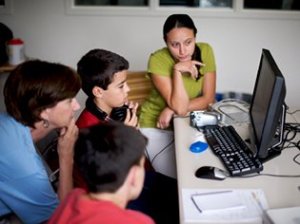Tech and Student-Led Conferencing
Some considerations for encouraging students to learn to use technology by exploring.
When a student asks, “How do I use this app?” I often respond by telling them to press some buttons and see what happens.

When I began incorporating student-led learning and Genius Hour into my class, I would respond to questions from students in a similar way. For example, I might answer a question with a question in true Yoda style, “Answer in me it is not—look within for the answer you seek.”
I make sure, however, that I consider the particular student as a learner before I answer. Specifically, I think about whether or not they have had much support in an inquiry-based or self-directed learning environment. If this is one of their first opportunities to guide their own learning, I’ve come to realize that they might require some more direction.
With the app example above, I decide whether the student should just “press buttons” or spend some time learning about the app from a tutorial online, or whether I should confer with them to learn the specifics of the issue. If I choose to confer, I seek to find out whether it is the learning goals that they’re having a hard time with or their technical know-how with the app itself. In essence, I confer with the student to find out exactly what they know, what they understand, and how well they can explain it, and then I make a plan for what they could do next.
At first glance, it may seem rather whimsical and idealistic to tell students to simply press buttons and give it a go. This is especially true since not every student has had the freedom to guide their own learning and try things out in their own way. For this reason, I suggest that we be careful when we invite students to own their own learning and use technology independently. I suggest that we apply the best teaching practices to the endeavors that require more student autonomy and ownership.
Some considerations:
- Gradually release responsibility, knowing that this will look different for different classes and students.
- Tech-based projects require accountability, so consider how students will showcase their learning and/or progress on long term projects. This way we can ensure focus, progress monitoring and accountability. See my iPad Workshop slides for ideas.
- The self-directed learner still requires a teacher and/or peer to motivate, inspire, make connections, facilitate, or redirect them.
- Formal and/or informal conferences or check-ins are mandatory. Just like conferring in other subjects, conferring with tech and student-led projects is insightful and necessary.
- It’s imperative to show examples, exemplars, and celebrations. Like with reading and writing, our ability to improve and become better at using technology comes with practice and a growth mindset.
- Follow through by giving student adequate time to work on projects, share projects, and then repeat.
Even though conferring is usually considered a part of reading and writing, the more I integrate technology and experiment with student-led models, the more I realize the necessity of conferring with each student. After being in 1:1 classrooms and observing students who suffer from an inability to move on their own ideas, I realized that conferring allows facilitation and redirection as needed.
Although tech and student-led models may have seemed disparate, I have included them both in this post as I believe they are more or less synonymous. In a technology-rich learning environment, we often find increasing amounts of student autonomy. The sheer choice of devices, platforms, apps, applications, etc. leads to choice and ownership, naturally. Not to mention, access to the world through the internet places information into the hands of our students, which also contributes to increased student-led learning.
So as we transfer ownership from teachers to students and increase student autonomy, we cannot forget to facilitate this process with the above considerations. Now, just as much as always, the role of the teacher is crucial. Thankfully, it doesn’t look as different as one would have guessed. Use the best practices from conferring in other subject areas to gain insights into the tech and other student-led endeavors. Be a coach, be a facilitator, be a guide-on-the-side, and be present.
Here’s a video of teachers discussing tech and student-led considerations.